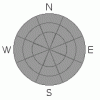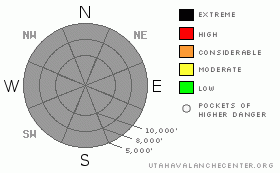SPECIAL ANNOUNCEMENT |
 |
We have ended our avalanche advisories for the season.
This does not mean the end of avalanches, nor the possibility of more avalanche incidents. But we have run out of money in a lean budget year combined with an extremely active avalanche season. We have not yet added up the official numbers, but it appears that there were well over 200 unintentional, human triggered avalanches in the backcountry, which shatters our previous record and is more than double the average of 100. Despite this, we ended the season with only four fatalities, which is our average.
Below, I have outlined some general strategies for avoiding spring avalanches.
We'd like to thank you, the public, for your support through the years. We'd also like to thank the Friends of the Utah Avalanche Center - an inspired and inspiring group of people dedicated to the cause of keeping people safe in the backcountry - Board President Paul Diegel, Colleen Graham, Mike Brehm, Scott Martin, Rich Mrazik, Jen Logan, John Curtis, Curt Kennedy, and Reid Persing. We would also like to thank our other major funding partners:Utah State Parks, Utah Dept of Public Safety, Salt Lake County, United Fire Authority,Ski Utah and our premier mountain resorts and the National Weather Service donates office space and weather forecasting services. There are many other important supporters foundhere. Thanks.
Look for our Annual Report due out sometime early summer. Archived Reports can be foundhere. |
|
|
BOTTOM LINE
Danger by aspect and elevation on slopes approaching 35° or steeper.
(click HERE for tomorrow's danger rating)
|
|
|
|
CURRENT CONDITIONS |

|
In our absence, you have a plethora of great information on current conditions:
Snow Page (from the National Weather Service)
SNOTEL Map (from NRCS)
Satellite Imagery (scroll down and click on Infrared > Western US > 2km > Animation)
Radar Imagery (click on the Composite Reflectivity > Loop) |
|
|
THREAT #1 |

|
| WHERE |
PROBABILITY |
SIZE |
TREND |

|
| No probability identified. |
|
|
|
|
|
Each spring, avalanche conditions become more predictable and our avalanche advisories end up repeating themselves like a broken record. So here is the usual spiel:
As my 93-year-old Czech mother-in-law reminds me, “Spring is always a fight between winter and summer.” We have alternating, cold, dry powder storms followed by warm, sunny weather that quickly turns the snowpack soggy.
First for storm snow: we have to worry about the usual round of avalanche activity that occurs during storms, namely instabilities within the new snow and wind slabs. Luckily, in spring, the new snow usually falls on a very stable pre-existing snowpack, so all the monkey business is near the surface. Be sure to use your usual round of tricks like jumping on small test slopes to see how they respond and dig down with your hand to see how well the snow is bonded. Also, you should never commit yourself to a slope without first putting a good slope cut across the slope to test it. If the slope fractures, hopefully, your momentum will take you off the moving slab. And as always, avoid steep slopes with recent wind deposits. |
|
|
THREAT #2 |

|
| WHERE |
PROBABILITY |
SIZE |
TREND |

|
| No probability identified. |
|
|
|
|
|
Between storms, the new snow turns soggy in a hurry with warm temperatures and strong spring sun. Always avoid steep, sun-exposed slopes when they begin to turn wet for the first time. They will often produce roller balls or pinwheels as a precursor to producing larger, wet or damp sluffs.
Second, watch for several unusually warm days in a row because percolating melt water can lubricate and weaken deeply buried weak layers, which produce large, dangerous, wet slabs. We often see these occur during very warm weather after 3 nights of no freezes or limited freezes, especially on a layered, winter-like snowpack, which has not experienced percolating melt water before. When playing on corn snow (melt-freeze snow) be sure to get out early and head home early—before the snow surface gets punchy.
Third, you need to avoid steep, rock slabs, which often produce glide avalanches in which the entire snowpack moves slowly like a glacier until it releases catastrophically. These releases can occur any time of day and counter intuitively seem to release more in the early morning hours, just when you expect it the least. In the Salt Lake mountains, glide avalanches occur like clockwork in places like Stairs Gulch, Broad’s Fork and Mill B South, which are always good places to avoid in spring. |
|
|
MOUNTAIN WEATHER |

|
Luckily, we also have an embarrassment of riches when it comes to weather forecasting. Here are some links we use regularly:
Cottonwood Canyons Forecast
Graphical forecast for Alta (You can click on any mountain location you want by using the map, which generates a forecast for where you click.)
To get fancy – and – if you know how to read weather maps…
Penn State
U of U time-height sections for SLC (Time is on the bottom axis and height in the atmosphere on the vertical axis—well—you just have to stare at it until it makes sense, but it’s extremely powerful.) |
|
|
GENERAL ANNOUNCEMENTS |
UDOT canyon closuresUDOTat (801) 975-4838
We appreciate all youravalanche and snow observations. You can also call us at 801-524-5304 or 800-662-4140, or fill out the observation form on our home page.
Donate to your favorite non-profit –The Friends of the Utah Avalanche Center.The UAC depends on contributions from users like you to support our work.
The information in this advisory is from the U.S. Forest Service, which is solely responsible for its content. This advisory describes general avalanche conditions and local variations always occur. |
|
|
This information does not apply to developed ski areas or highways where avalanche control is normally done. This advisory is from the U.S.D.A. Forest Service, which is solely responsible for its content. This advisory describes general avalanche conditions and local variations always occur. |
|
This advisory provided by the USDA Forest Service, in partnership with:
The Friends of the Utah Avalanche Center, Utah Division of State Parks and Recreation, Utah Division of Emergency Management, Salt Lake County, Salt Lake Unified Fire Authority and the friends of the La Sal Avalanche Center. See our Sponsors Page for a complete list. |



